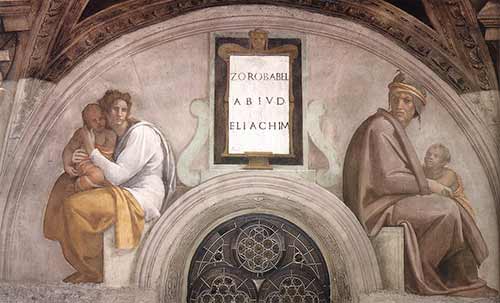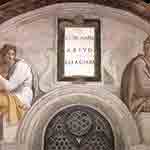
and Zerubbabel the father of Abiud, and Abiud the father of Eliakim, and Eliakim the father of Azor, and Azor the father of Zadok, and Zadok the father of Achim, and Achim the father of Eliud, and Eliud the father of Eleazar, and Eleazar the father of Matthan, and Matthan the father of Jacob, and Jacob the father of Joseph the husband of Mary, of whom Jesus was born, who is called the Messiah. (Matthew 1:13-16)
Ζοροβάβελ δὲ ἐγέννησεν τὸν Ἀβιούδ Ἀβιοὺδ δὲ ἐγέννησεν τὸν Ἐλιακείμ Ἐλιακεὶμ δὲ ἐγέννησεν τὸν Ἀζώρ
Ἀζὼρ δὲ ἐγέννησεν τὸν Σαδώκ Σαδὼκ δὲ ἐγέννησεν τὸν Ἀχείμ Ἀχεὶμ δὲ ἐγέννησεν τὸν Ἐλιούδ
Ἐλιοὺδ δὲ ἐγέννησεν τὸν Ἐλεάζαρ Ἐλεάζαρ δὲ ἐγέννησεν τὸν Ματθάν Ματθὰν δὲ ἐγέννησεν τὸν Ἰακώβ
Ἰακὼβ δὲ ἐγέννησεν τὸν Ἰωσὴφ τὸν ἄνδρα Μαρίας, ἐξ ἧς ἐγεννήθη Ἰησοῦς, ὁ λεγόμενος Χριστός
This is the ninth post in a series – you can begin here:
Matthew in Slow Motion 1
Matthew in Slow Motion 2
Matthew in Slow Motion 3
Matthew in Slow Motion 4
Matthew in Slow Motion 5
Matthew in Slow Motion 6
Matthew in Slow Motion 7
Matthew in Slow Motion 8
As this year the Sunday Gospel readings’ focus is on St Matthew’s Gospel, I thought I’d start some of my personal study and Lectio Divina with that Gospel. [NB. I am using ‘Matthew’ as a convenient term for the author of the first Gospel in the order of the Christian canon].
I’ve already noted that Zerubbabel was last in Matthew’s list for whom there is Old Testament mention. For all the rest in Matthew’s list, he is not using the Old Testament as a source.
Some commentators suggest that Matthew got his list from genealogies kept in the Temple (e.g. Michael J. Wilkins).
There is inconsistency between Matthew’s genealogy and Luke’s. This, of course, is of concern to those who must have every historical detail in the Bible correct. Solutions include that
Matthew give the genealogy of Jesus through Joseph, the legal, though not the physical father of Jesus. Luke, on the other hand, gives the ancestry of Jesus through Mary from whom Jesus was descended physically as to his humanity.
That would be nice, but, of course, it’s false. Both trace the genealogy to Joseph.
So, for example, Matthew has Joseph’s dad being Jacob. Luke has Joseph’s dad being Heli.
Matthew, in his story, stresses Joseph as a dreamer. To reinforce this point, in echoing the Old Testament Joseph-the-dreamer connection, he has this New Testament Joseph having a dad named the same as the Old Testament Joseph.
Modern scholarship tends to see the genealogies of Jesus as theological constructs rather than factual history: family pedigrees would not usually have been available for non-priestly families, and the contradictions between the two lists are seen as clear evidence that these were not based on genealogical records. Additionally, the use of titles such as ‘Son of God’ and ‘Son of David’ are seen as evidence that they do not come from the earliest Gospel traditions. Raymond E. Brown says the genealogies “tell us nothing certain about his grandparents or his great-grand-parents”.
Gundry suggests the series of unknown names in Matthew connecting Joseph’s grandfather to Zerubbabel as an outright fabrication.
To be continued…
If you appreciated this post, consider liking the liturgy facebook page, using the RSS feed, and/or signing up for a not-very-often email, …




The errors within Matthew’s genealogy of Jesus, and the difference between Matthew and Luke, present a problem for anyone with a respectful view of Scripture, whether they hold the view that Scripture in its original autographs is inerrant or whether their view tolerates admission of some degree of error even in the original autographs. However, all the “explanations” that have been presented from the early centuries of the Church to the present time are simply speculations. Who knows – perhaps some dead-sea-scroll-like discovery will lead to more certainty, but without that, what we have in hand are speculations.
R. H. Gundry was attempting to remain true to evangelical conservatism but felt that the application of redaction criticism gave him the liberty to suppose that the part of the Matthew genealogy from Zerubbabel to Joseph might be an outright fabrication. His view met with a mixed response from evangelical scholars. Many would, I’m sure, have held that the superintendence of the Spirit of Truth over the creation of the Scriptures would have kept Matthew from such an artifice, even if it might have been acceptable according to literary standards of the author’s time and place.
I agree with that concern. Rearrangement of the timing of various gospel events so that the events are grouped thematically rather than chronologically – certainly. The Spirit of Truth is not bound by our modern idea that truth has to be presented chronologically or with precise literalism or it fails as truth. For me, though, to suppose the inclusion of deliberate falsehood is a step too far. It is one thing to agree, for instance, that the author of the book of Esther used a satirical pseudonym, Ahasuerus, instead of the king’s real name, Xerxes, but it is another thing entirely to say that the Esther story is fiction and that nothing like it happened in real history.
Therefore, I need to suppose that one of the historic conservative explanations is probably correct. Is a levirate marriage the underlying reason for the discrepant lists, or does one show the ancestry of Joseph and the other the ancestry of Mary? I don’t know – but neither does Gundry know for a certainty that the latter part of Matthew’s list is a fabrication.
Interestingly, you write concerning the Mary hypothesis, “That would be nice, but, of course, it’s false. Both trace the genealogy to Joseph.” Your words imply that you, like me, believe that there is meaningful, God-given truth to be found and you are seeking to discern it in the face of the disparity between Matthew and Luke. Perhaps I’m less conservative than you in being willing to countenance that either Matthew or Luke ascribed to Joseph a lineage that the evangelist knew full well was Mary’s!
The Wikipedia article to which you linked says, “…family pedigrees would not usually have been available for non-priestly families.” They may not have been formally kept, but do we really know that they were not kept informally? And, if a family knew that the great King David was one of their ancestors, may they not have had an especial motivation to pass the knowledge down through the generations? If so, both Matthew and Luke may have been operating from lists whose provenance they knew.
Of course, I’m speculating, as was St Augustine in his time and Gundry in ours. I do think I have a witness, though, that suggests that my speculations are more likely correct than Gundry’s, and that is the Scriptures’ own testimony to the close involvement of the Triune God in their writing. I think, for instance, of Romans 3:1-2 – “…what advantage has the Jew? Or what is the value of circumcision? Much in every way. To begin with, the Jews were entrusted with the oracles of God” (ESV) (Of course, as a conservative evangelical, I can build my case more widely than that.)
Anyway, enough for now. I trust we can agree on the speculative nature of all the proposed solutions. Thanks for your provocative work in the “Matthew in Slow Motion” series. I look forward to the next issue.
Trevor Morrison
Thanks, Trevor. I wonder how “Matthew or Luke ascribed to Joseph a lineage that the evangelist knew full well was Mary’s” differs from “the inclusion of deliberate falsehood”? More significantly: do pop back tomorrow (spoiler) you will feature. Blessings.
Just throw in a pinch of redaction criticism. 🙂 What if, in the evangelists’ thinking, a wife’s ancestry was as truly her husbands as her own? I know – more speculation! I can hear you telling me to give in and admit that there is an intractable error (as we in modern terms would define “error”) here, but I remain comfortable that there exists a better explanation, even if we never know what it is.
Dear Rev. Bosco Peters:
I wish to invite you to read my articles that were published in “Revista Biblica” (Buenos Aires, Argentina). They can be found in the following PDF files:
“The Genealogies of Jesus” (RevBibl 71/3-4 [2009] 193-218)
http://www.pesquisasbiblicas.com.br/enggenjesus.pdf
“The Genealogies of Jesus: a complementation” (RevBibl 73/3-4 [2011] 117-129)
http://www.pesquisasbiblicas.com.br/enggenjesuscompl.pdf
My articles contain new details on the issues.
If possible, I would like to get your impressions about them.
I hope that my articles help you in your Bible researches.
Sincerely yours,
Adylson Valdez.
Thanks so much, Adylson, for sharing these wonderful articles with us all here. They will require more time to work through carefully. If anyone has a comment about them, they can add them here. Blessings.
I am at your disposal to clarify any doubts about my theories in my articles. I invite all of you who would like to discuss them in detail.
I send below a passage extrated from my article “The Genealogies of Jesus”, which summarizes the way in which the Matthean and Lukan genealogical lists have been made. I would like to put this passage under discussion, if possible. I shall explain the doubts that can arise from it.
In the present article it has been demonstrated that Jesus Christ’s genealogies were elaborated according to name and lineage models that follow chronological order and biblical History, as well as internal symbolical-theological principles that obeyed intervals with significant numerical groups.
Several new details were brought into the picture, among which the most important are the following:
1. As for the harmonization theses and the theses that include Mary, the hypothetical alternative that she might be a descendant of David’s through some other son, rather than Solomon and Nathan. This alternative helps us to discard these complicated theses.
2. In the case of Matthew’s genealogy, the use of ascribing different names to some of the ancestors, such as Eliachim in reference to Jechonias and Azor in reference to Ozias; the abbreviations of Achimaaz to Achim and Mathaniah to Mathan; the possible modification of Azariah to Azor if we consider 1 Chron 6.8-10, for this passage must have inspired the creation of the Azor-Zadok-Achim set; the connections between Abiud and Joseph, Zadok and Achim, Eliud and Abiud, Eleazar and Zadok; and Mathan’s typological introductory function in the group Mathan-Jacob-Joseph-Jesus.
3. In regard to Luke’s genealogical list, the verification that the first seven names form a group that serves as a generating principle for other names, which thus causes its detachment from the rest of the genealogy; the possible influence of several nominal forms found in the Old Testament; the reutilization of names, though with altered forms, such as Joseph-Josech, Eli-Esli, Judah-Joda, Semein-Simeon, and Joanan-Jonam; the existence of subgroups organized according to the initial letters in names; the symbolical-numerical relation between names with approximate forms; the numerical constancy of the intervals with seven, twenty-eight, eighteen, and ten, as well as, in a secondary way, twenty-six and fifty-two; the possible use of meanings for the choice of key-names; the theological intention to remove Jesus’ status as Israelite royalty from him through the diversion using Nathan; the connection between the names Addi, Admin, and Adam by similarity and root, which is confirmed through the evangelist’s symbolical-numerical system; and the proposal that Arni is closer to the form Arnan.
It is a pity that no one has wanted to reply my comment. I was disappointed with this fact. But nevertheless, I believe that I have fulfilled my purpose. A huge hug to all!
Certainly, Adylson, I appreciated your contribution. I often put lots of work into a post here without receiving any feedback – but I know people read and appreciate what is here. Blessings.